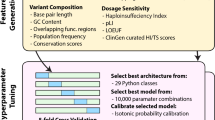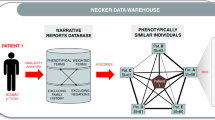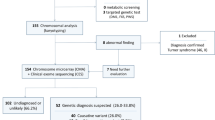Abstract
Interpretation of pediatric chromosome microarray (CMA) results presents diagnostic and medical management challenges. Understanding management practices triggered by CMA will inform clinical utility and resource planning. Using a retrospective cohort design, we extracted clinical and management-related data from the records of 752 children with congenital anomalies and/or developmental delay who underwent CMA in an academic pediatric genetics clinic (2009–2011). Frequency distributions and relative rates (RR) of post-CMA medical recommendations in children with reportable and benign CMA results were calculated. Medical recommendations were provided for 79.6% of children with reportable results and 62.0% of children with benign results. Overall, recommendations included specialist consultation (40.8%), imaging (32.5%), laboratory investigations (17.2%), surveillance (4.6%), and family investigations (4.9%). Clinically significant variants and variants of uncertain clinical significance were associated with higher and slightly higher rates of management recommendations, respectively, compared with benign/no variants (RR=1.34; 95% CI (1.22–1.47); RR=1.23; 95% CI (1.09–1.38)). Recommendation rates for clinically significant versus uncertain results depended upon how uncertainty was classified (RRbroad=1.09; 95% CI (0.99–1.2); RRnarrow=1.12; 95% CI (1.02–1.24)). Recommendation rates also varied by the child’s age and provider type. In conclusion, medical recommendations follow CMA for the majority of children. Compared with benign CMA results, clinically significant CMA variants are a significant driver of pediatric medical recommendations. Variants of uncertain clinical significance drive recommendations, but to a lesser extent. As a broadening range of specialists will need to respond to CMA results, targeted capacity building is warranted.
Similar content being viewed by others
Log in or create a free account to read this content
Gain free access to this article, as well as selected content from this journal and more on nature.com
or
References
Manolio TA, Chisholm RL, Ozenberger B et al: Implementing genomic medicine in the clinic: the future is here. Genet Med 2013; 15: 258–267.
Johansen Taber KA, Dickinson BD, Wilson M : The promise and challenges of next-generation genome sequencing for clinical care. JAMA Intern Med 2014; 174: 275–280.
Regier DA, Friedman JM, Marra CA : Value for money? Array genomic hybridization for diagnostic testing for genetic causes of intellectual disability. Am J Hum Genet 2010; 86: 765–772.
Trakadis Y, Shevell M : Microarray as a first genetic test in global developmental delay: a cost-effectiveness analysis. Dev Med Child Neurol 2011; 53: 994–999.
Miller DT, Adam MP, Aradhya S et al: Consensus statement: chromosomal microarray is a first-tier clinical diagnostic test for individuals with developmental disabilities or congenital anomalies. Am J Hum Genet 2010; 86: 749–764.
Baldwin EL, Lee JY, Blake DM et al: Enhanced detection of clinically relevant genomic imbalances using a targeted plus whole genome oligonucleotide microarray. Genet Med 2008; 10: 415–429.
Manning M, Hudgins L, Professional Practice and Guidelines Committee: Array-based technology and recommendations for utilization in medical genetics practice for detection of chromosomal abnormalities. Genet Med 2010; 12: 742–745.
Duncan A, Langlois S, SOGC Genetics Committee, CCMG Prenatal Diagnosis Committee: Use of array genomic hybridization technology in prenatal diagnosis in canada. J Obstet Gynaecol Can 2011; 33: 1256–1259.
Ormond KE, Wheeler MT, Hudgins L et al: Challenges in the clinical application of whole-genome sequencing. Lancet 2010; 375: 1749–1751.
Yngvadottir B, Macarthur DG, Jin H, Tyler-Smith C : The promise and reality of personal genomics. Genome Biol 2009; 10: 237.
Tsuchiya KD, Shaffer LG, Aradhya S et al: Variability in interpreting and reporting copy number changes detected by array-based technology in clinical laboratories. Genet Med 2009; 11: 866–873.
Ali-Khan SE, Daar AS, Shuman C, Ray PN, Scherer SW : Whole genome scanning: resolving clinical diagnosis and management amidst complex data. Pediatr Res 2009; 66: 357–363.
Glauser W : Standardization of genetic tests needed. CMAJ 2010; 182: E705–E706.
Cancer Care Ontario: Ensuring access to high quality molecular oncology laboratory testing and clinical cancer genetic services in ontario. Rep Mol Oncol Task Force 2008.
Micheel CM, Nass SJ, Omenn GS (eds): Evolution of translational omics: lessons learned and the path forward, Committee on the Review of Omics-Based Tests for Predicting Patient Outcomes in Clinical Trials; Board on Health Care Services; Board on Health Sciences Policy; Institute of Medicine, 2012. Available at: http://www.iom.edu/Reports/2012/Evolution-of-Translational-Omics.aspx.
Veenstra DL, Roth JA, Garrison Jr LP, Ramsey SD, Burke W : A formal risk-benefit framework for genomic tests: facilitating the appropriate translation of genomics into clinical practice. Genet Med 2010; 12: 686–693.
Miller I, Ashton-Chess J, Spolders H et al: Market access challenges in the EU for high medical value diagnostic tests. Future Med 2011; 8: 137–148.
Wideroff L, Phillips KA, Randhawa G et al: A health services research agenda for cellular, molecular and genomic technologies in cancer care. Public Health Genomics 2009; 12: 233–244.
Rogowski WH, Grosse SD, Khoury MJ : Challenges of translating genetic tests into clinical and public health practice. Nat Rev Genet 2009; 10: 489–495.
Riggs E, Wain K, Riethmaier D et al: Chromosomal microarray impacts clinical management. Clin Genet 2013; 85: 147–153.
Becker F, van El CG, Ibarreta D et al: Genetic testing and common disorders in a public health framework: how to assess relevance and possibilities. background document to the ESHG recommendations on genetic testing and common disorders. Eur J Hum Genet 2011; 19 (Suppl 1): S6–44.
Grosse SD, Khoury MJ : What is the clinical utility of genetic testing? Genet Med 2006; 8: 448–450.
Teutsch SM, Bradley LA, Palomaki GE et al: The evaluation of genomic applications in practice and prevention (EGAPP) initiative: methods of the EGAPP Working Group. Genet Med 2009; 11: 3–14.
Burke W, Burton H, Hall AE et al: Extending the reach of public health genomics: what should be the agenda for public health in an era of genome-based and "personalized" medicine? Genet Med 2010; 12: 785–791.
Saam J, Gudgeon J, Aston E, Brothman AR : How physicians use array comparative genomic hybridization results to guide patient management in children with developmental delay. Genet Med 2008; 10: 181–186.
Coulter ME, Miller DT, Harris DJ et al: Chromosomal microarray testing influences medical management. Genet Med 2011; 13: 770–776.
Ellison JW, Ravnan JB, Rosenfeld JA et al: Clinical utility of chromosomal microarray analysis. Pediatrics 2012; 130: e1085–e1095.
Henderson LB, Applegate CD, Wohler E, Sheridan MB, Hoover-Fong J, Batista DA : The impact of chromosomal microarray on clinical management: a retrospective analysis. Genet Med 2014; 16: 657–664.
Liu J, Bernier F, Lauzon J, Lowry RB, Chernos J : Application of microarray-based comparative genomic hybridization in prenatal and postnatal settings: three case reports. Genet Res Int 2011; 2011: 976398.
Ontario Genetics Secretariat. Genetic testing, services and research: contributing to the future healthcare of ontarians. 26 February 2009.
Tarini BA, Clark SJ, Pilli S et al: False-positive newborn screening result and future health care use in a state medicaid cohort. Pediatrics 2011; 128: 715–722.
Tu WJ, He J, Chen H, Shi XD, Li Y : Psychological effects of false-positive results in expanded newborn screening in china. PLoS One 2012; 7: e36235.
Harris PA, Taylor R, Thielke R, Payne J, Gonzalez N, Conde JG : Research electronic data capture (REDCap)—a metadata-driven methodology and workflow process for providing translational research informatics support. J Biomed Inform 2009; 42: 377–381.
United Nations Statistics Division. Composition of macro geographical (continental) regions and geographical sub-regions. http://unstats.un.org/unsd/methods/m49/m49regin.htm. Accessed 19 October 2012.
Robinson PN, Mundlos S : The human phenotype ontology. Clin Genet 2010; 77: 525–534.
Kearney HM, Thorland EC, Brown KK, Quintero-Rivera F, South ST, Working Group of the American College of Medical Genetics Laboratory Quality Assurance Committee: American College of Medical Genetics Standards and Guidelines for Interpretation and Reporting of Postnatal Constitutional Copy Number Variants. Genet Med 2011; 13: 680–685.
Wheeler RE The R project for statistical computing. http://www.r-project.org Updated 2009. Accessed 18 March 2004.
R Development Core Team A Language and Environment for Statistical Computing. Vienna, Austria: R Foundation for Statistical Computin, 2009, http://www.R-project.org.
Michelson DJ, Shevell MI, Sherr EH et al: So what? does the test lead to improved health outcomes? Neurology 2012; 78: 440–441.
Wimalasundera RC, Gardiner HM : Congenital heart disease and aneuploidy. Prenat Diagn 2004; 24: 1116–1122.
Barakat AY, Butler MG : Renal and urinary tract abnormalities associated with chromosome aberrations. Int J Pediatr Nephrol 1987; 8: 215–226.
McGrew SG, Peters BR, Crittendon JA, Veenstra-Vanderweele J : Diagnostic yield of chromosomal microarray analysis in an autism primary care practice: which guidelines to implement? J Autism Dev Disord 2012; 42: 1582–1591.
Caulfield T, Evans J, McGuire A et al: Reflections on the cost of "low-cost" whole genome sequencing: framing the health policy debate. PLoS Biol 2013; 11: e1001699.
Girirajan S, Rosenfeld JA, Coe BP et al: Phenotypic heterogeneity of genomic disorders and rare copy-number variants. N Engl J Med 2012; 367: 1321–1331.
Boone PM, Wiszniewski W, Lupski JR : Genomic medicine and neurological disease. Hum Genet 2011; 130: 103–121.
Acknowledgements
This work is supported by the Accelerator Grant in Genomic Medicine, McLaughlin Centre, University of Toronto and by the Centre for Genetic Medicine, The Hospital for Sick Children.
Author information
Authors and Affiliations
Corresponding author
Ethics declarations
Competing interests
The authors declare no conflict of interest.
Rights and permissions
About this article
Cite this article
Hayeems, R., Hoang, N., Chenier, S. et al. Capturing the clinical utility of genomic testing: medical recommendations following pediatric microarray. Eur J Hum Genet 23, 1135–1141 (2015). https://doi.org/10.1038/ejhg.2014.260
Received:
Revised:
Accepted:
Published:
Issue date:
DOI: https://doi.org/10.1038/ejhg.2014.260
This article is cited by
-
Association between Copy Number Variation and Response to Social Skills Training in Autism Spectrum Disorder
Scientific Reports (2019)
-
Care and cost consequences of pediatric whole genome sequencing compared to chromosome microarray
European Journal of Human Genetics (2017)
-
Parents’ Perceptions of the Usefulness of Chromosomal Microarray Analysis for Children with Autism Spectrum Disorders
Journal of Autism and Developmental Disorders (2015)



